18 Jun – 22 Aug 2021
Image Bank
-
Martin Bartlett
ArtistMartin Bartlett (English, 1939-1993) was an electronic musician and composer. After immigrating to Canada in 1952, he studied English and Music at UBC under Barbra Pentland and went on to complete an MFA in composition from Mills College in California in 1968. Bartlett was interested in non-Western compositional and philosophical practices and had vital connections with the music and cultures of South Asia. He traveled extensively in Indonesia and made hours of field recordings, many of which were accompanied by vivid narrations of rituals and ceremonies he was documenting. Bartlett’s music and compositions explored a wide range of themes involving intersections between text, performance, non-musicians, hand-built electronics and live interaction with computer-controlled synthesizers, all with a persistent emphasis on live, ephemeral and collaborative situations. In 1973, Bartlett co-founded the Western Front Society with Mo van Nostrand, Kate Craig, Henry Greenhow, Glenn Lewis, Eric Metcalfe, Michael Morris and Vincent Trasov and curated the Music Program there. He was the first head of the electronic studio at the University of Victoria, where he also taught as an Associate Professor in Composition, Theory and World Music from 1975-1983. In 1982 he was made a Professor at Simon Fraser University (SFU). Bartlett later founded the Vancouver Community Gamelan in 1986. He passed away at the age of 54 in 1993 from complications arising from AIDS.
Read More
-
Taki Bluesinger
ArtistTaki Bluesinger (Takao Sekiguchi) (Japanese, Canadian, 1943-2004) was a lens-based artist. Born in Saitama, Japan in 1943, he immigrated to Vancouver, BC in 1969, after refusing an assignment from Time Magazine to go to Vietnam. Bluesinger quickly became involved in Vancouver-based artistic groups including the Intermedia Society and the New Era Social Club. Beginning in the 1970s, he participated in many collaborative photography, video and performance projects with artists Michael de Courcy, Gerry Gilbert, Glenn Lewis, Michael Morris, Vincent Trasov and Carole Itter. These projects included Image Bank (1970–1978), Background/Vancouver (1972), Video Bag (1974), The Edge of Sleep (1977), 13 Cameras (1978), The Origins of Man-Made Paradise (1978) and Teaching and Learning as Performing Arts Part II (1998). Bluesinger’s works have been exhibited nationally and internationally, and have been featured in exhibitions, including Yellow Peril: Reconsidered at Artspeak (1990), Gardens at Canadian Museum of Contemporary Photography (1998), Drawing with Light at the Canadian Museum of Contemporary Photography (2001-02) and Image Bank at the Morris and Helen Belkin Art Gallery (2021).
Read More
-
Hank Bull
ArtistHank Bull (Canadian, b. 1949) is an artist working in performance art, radio, shadow theatre, publishing and curation. Bull’s artistic practice utilizes ephemera and targets unconventional spaces and modes of improvisations. This involves his extensive work in radio and television, which he considers a medium of art.These works have included a collaboration with Patrick Ready in their production of an original radio show, The HP Dinner Show, which ran for eight years on Vancouver Co-operative Radio. Alongside his art practice, Bull is noted for his role as an arts organizer who produces networks and collaborations with artists nationally and internationally. He was an early member of the Western Front Society and a founding director of the Pacific Association of Artist-run Centres. In 1998, he co-founded Centre A, the Vancouver International Centre of Contemporary Asian Art. His work has been shown internationally, including at the Venice Biennale (1986) and Documenta (1987), and is held in the permanent collections of Musée d’art Contemporain de Montréal, the National Gallery of Canada and the Museum of Modern Art in New York. Bull was awarded an honorary Doctorate of Letters from Emily Carr University of Art + Design in 2014.
Read More
-
Kate Craig
ArtistKate (Catherine) Shand Craig (Canadian, 1947-2002) was a multimedia artist whose work spanned costume, film, performance and photography. Craig experimented with role-play and costumes in performance and video. She adopted the camera as a mediating device to challenge the conventions of realist narratives around the female body and the natural landscape. After graduating from Dalhousie University in 1964, Craig met the artist Eric Metcalfe in 1967 while attending the University of Victoria. Together, they assumed the personas of Lady Brute and Dr. Brute and became involved in mail art networks, including Image Bank, International Image Exchange Directory and the first International Satellite Exchange Directory. In 1973, Craig co-founded the Western Front Society along with Martin Bartlett, Mo van Nostrand, Henry Greenhow, Glenn Lewis, Eric Metcalfe, Michael Morris and Vincent Trasov. While serving on the board of directors at the Western Front from 1973 to 1993, Craig curated the Artist-in-Residence Video Program, which provided local and international networks for artists. Her works have been presented nationally and internationally in exhibitions and can be found in the collections of the Art Gallery of Greater Victoria, Museé d’Art Contemporain de Montréal and the National Gallery of Canada.
Read More
-
General Idea
ArtistGeneral Idea (1969-1994) was a Canadian-based art collective comprised of AA Bronson, born Michael Tims (Canadian, b. 1946), Felix Partz, born Ronald Gabe (Canadian, 1945-1994) and Jorge Zontal, born Slobodan Saia-Levy (Italian, 1944-1994). Their practice largely involved unconventional media of mail art, performance art and installation using ideas of appropriation, satire and conceptualism, often taking on political issues, most notably challenging dominant ideas of capitalist heteronormativity. Through the focus on their activities as a collective, General Idea sought to remove the individualistic notions of artist-as-genius and further queer the art space through their integration of domestic life and popular culture with artistic practice. Their work can be found in the permanent collections of the Vancouver Art Gallery, the Art Gallery of Ontario, the New York Museum of Modern Art, and the San Francisco Museum of Modern Art among others. The archive is held at the National Gallery of Canada. The collective’s activities stopped in 1994 when both Partz and Zontal passed away due to complications from AIDS.
Read More
-
Geoffrey Hendricks
ArtistGeoffrey Hendricks (American, 1931-2018) was a painter, performance and installation artist affiliated with the Fluxus movement beginning in the 1960s. Recognized for the extensive portrayals of skies throughout his work, he became known by the moniker “Cloudsmith,” given to him by Dick Higgins. Informed by his Quaker upbringing alongside an interest in Zen philosophy and thought, his work actively sought an integration between art and life, and questions of the material versus the transcendent and the spiritual versus the practical. Much of Hendricks’s practice was grounded in collaboration and queer kinship ties, and in the 1980s he became involved with Visual AIDS, an organization preserving the work and legacies of artists with HIV/AIDS. Over the course of his career, he taught at Rutgers University, the Skowhegan School of Painting and Sculpture and the Salzburg International Summer Academy of Fine Arts. Hendricks’s work has been shown internationally in numerous exhibitions and festivals. In 2003 he curated Critical Mass: Happenings, Fluxus, Performance, Intermedia and Rutgers University, 1958-1972 at the Mead Art Museum (Amherst) and the Mason Gross Art Galleries (Rutgers).
Read More
-
Ray Johnson
ArtistRay Johnson (American, 1926-1995) was an artist celebrated for his contributions to the Neo-Dada and Pop Art movements, and has been credited as a key founder of the genres of mail and correspondence art, most notably his New York Correspondence School. During his studies at Black Mountain College in North Carolina he encountered lecturers and visiting faculty including John Cage, Joseph Alpers and Robert Motherwell, who inspired his practice and interest in language and collage. In the 1950s, Johnson became known for his “moticos,” a coined term for collages that featured layered newspaper articles, photographs, fragmented lists and doodles finished with a polished surface. Alongside collage and correspondence art, Johnson’s practice included the creation of the Robin Gallery, an art space with no physical location. This immaterial gallery existed as publicity for Johnson and his network and speaks to his ubiquitous presence in the art world. Johnson’s work is collected internationally, including the collections of the Metropolitan Museum of Art (New York), the Tate Modern (London), Hammer Museum (Los Angeles) and Museum moderner Kunst Stiftung Ludwig Wien (Vienna).
Read More
-
Gary Lee-Nova
ArtistGary Lee-Nova is a Vancouver-based artist. He studied at the Vancouver School of Art (now Emily Carr University of Art + Design) (1960-61, 1962-63) and at Coventry College of Art, England (1961-62). An important figure in the West Coast scene of the 1960s and 1970s, Lee-Nova made his name as a painter working in hard-edge style. In 1970, Lee-Nova co-founded Image Bank with Michael Morris and Vincent Trasov and was an active participant in the Sound Gallery (c. 1965), Intermedia (1967-72) and the New York Corres Sponge Dance School of Vancouver under the pseudonym Artimus Rat or Art Rat. His work has been exhibited at spaces such as the Vancouver Art Gallery, Bau-Xi Gallery, University of Saskatchewan, the Western Front, the Morris and Helen Belkin Art Gallery, the National Gallery of Canada, the Paris Biennale and the Burnaby Art Gallery. His work is included in collections such as the National Gallery of Canada, Canada Council Art Bank, and Institute of Contemporary Art (London) and the Vancouver Art Gallery. Most recently, the Burnaby Art Gallery held a survey show of Lee-Nova’s work entitled Oblique Trajectories.
Read More
-
Glenn Lewis
ArtistGlenn Lewis (Canadian, b. 1935) is a contemporary conceptual artist based in Vancouver. Lewis became a central figure within Vancouver’s prolific avant-garde art scene of the late 1960s. Initially trained in ceramics, his practice expanded to include photography, sculpture, performance and video, and is often grounded in collaborative projects or approaches. Lewis’s work questions the dualities of the social and the natural, the conventional and the mythical, as well as the static and the transient, often ironically. In 1967, Lewis was prominent in Intermedia, a loose collective of artists, musicians, dancers, architects, engineers and educators who came together to explore new forms of artistic expression and equipment, influenced in part by the ideas of Marshall McLuhan, Buckminster Fuller, the back-to-the-land movement, performance and conceptual art. Lewis was first inspired to take up performance art himself after attending workshops with choreographers and dancers Deborah Hay and Steve Paxton at the Vancouver Art Gallery in 1968, and the following year participating in a performance tour with his piece Canadian Pacific and Yvonne Rainer’s Rose Fractions. Lewis received a degree from the Vancouver School of Art in 1958 (now Emily Carr University) and later a teaching degree from the University of British Columbia. He went on to study ceramics under artist and potter Bernard Leach at St. Ives in Cornwall, England from 1961 to 1963. Upon returning to Vancouver, Lewis became involved in numerous artists’ collectives and artist-run centres, including Intermedia (1967) and the New Era Social Club (1968). In 1973, he co-founded the Western Front Society with Martin Bartlett, Mo van Nostrand, Kate Craig, Henry Greenhow, Eric Metcalfe, Michael Morris and Vincent Trasov. As an educator, arts administrator and arts programmer, Lewis has curated numerous exhibitions and programs, including the Performance Art Program at the Western Front (1977-79), the Exhibition Program at the Western Front (1986-87) and the Western Front Historical Exhibition at the Künstlerhaus Stuttgart, Germany (1983). Lewis has served on numerous boards and councils, including the Vancouver Art Gallery Board of Directors and the Western Front Board of Directors. His work has been exhibited extensively across Canada and abroad.
Read More
-
Eric Metcalfe
Eric Metcalfe (Canadian, b. 1940) is a visual and performance artist known for his affiliation with the Fluxus art movement. Metcalfe’s interdisciplinary practice encompasses painting, drawing, sculpture, installation, printmaking, performance, video and film. Born in Vancouver, Metcalfe’s lifelong passions of art, jazz, drawing and printmaking began while attending St. Michael’s University School in Victoria, and he went on to pursue a BFA from the University of Victoria in 1963. Metcalfe met artist Kate Craig in 1967. Together, they assumed the personas of Dr. Brute and Lady Brute and became involved in mail art networks, including Image Bank, International Image Exchange Directory and the first International Satellite Exchange Directory. Alongside his involvement in Image Bank, Metcalfe was a co-founder of the Vancouver artist-run centre Western Front along with Martin Bartlett, Kate Craig, Henry Greenhow, Glenn Lewis, Michael Morris, Vincent Trasov and Mo Van Nostrand, where he continues to be a member. Metcalfe has received numerous awards and recognition for his work, including the Victor Martyn Lynch-Staunton Award (2000), the Audain Foundation Lifetime Achievement Award (2006), the Governor General’s Award (2008) and an Honorary Doctorate from Emily Carr University of Art + Design (2015). His work has been exhibited widely in both Canada and abroad, including at the National Gallery of Canada, the Vancouver Art Gallery, the Morris and Helen Belkin Art Gallery, the Whitney Museum of American Art and the Museum of Modern Art (New York).
Read More
-
Michael Morris
ArtistMichael Morris (1942-2022) was a painter, photographer, video and performance artist and curator. His work is often media based and collaborative, involved with developing networks and in the production and presentation of new art activity. In his roles as curator and, primarily, as an artist, Morris was a key figure of the West Coast art scene during the 1960s. Morris studied at the University of Victoria and then at the Vancouver School of Art (now Emily Carr University), followed by graduate studies at Slade School of Fine Art at the University College London, during the 1960s. There he became interested in the work of Fluxus and the European avant-garde, which had a profound influence on his work and on the Vancouver experimental art scene in general. In 1969 he founded Image Bank with Vincent Trasov, a system of postal correspondence between participating artists for the exchange of information and ideas. The intention of Image Bank was to create a collaborative, process-based project in the hopes of engendering a shared creative consciousness—in opposition to the alienation endemic to modern capitalist society—through the deconstruction and recombination of its ideological forms. Morris was acting curator of the Vancouver Art Gallery and the Centre for Communications and the Arts at Simon Fraser University and has had many guest curatorships at other institutions. In 1973, he co-founded the Western Front—one of Canada’s first artist-run centres—and served as co-director for seven years. In 1990 he and Trasov founded the Morris/Trasov Archive, housed at the Morris and Helen Belkin Art Gallery, to research contemporary art. He has established a strong international reputation and worked for many years in Berlin. Morris has participated in artist-in-residence programs both in Canada at the Banff Centre (1990) and at Open Studio (2003) and internationally at Berlin Kustlerprogramm (1981-1998). Morris has had numerous solo and collaborative exhibitions nationally and internationally, and is the recipient of numerous awards, including the 2015 Audain Prize for Lifetime Achievement in Visual Arts, the 2011 Governor General’s Award in Visual and Media Arts and an Honorary Doctorate in 2005 by Emily Carr University of Art + Design.
Read More
-
Vincent Trasov
ArtistAn important Canadian conceptual artist and a leader in the avant-garde community, Vincent Trasov (b. 1947, Edmonton, AB) is a painter, video and performance artist. His work is often media-based and collaborative in spirit, involved with developing networks. In 1969 he founded Image Bank with Michael Morris, a method for personal exchange of information amongst artists. Trasov has made videotapes since 1971. In 1973, Trasov co-founded and co-directed the Western Front Society, an artist-run centre for the production and presentation of new art activity. Trasov gained international prominence with his performance as Mr. Peanut (in a Planter’s Peanut costume), an official candidate for Mayor of Vancouver in 1974. The Mr. Peanut role was intended as, amongst other things, a commentary about the perceived merging of art and politics. In 1981, he was invited to Berlin with Michael Morris as guest of Berliner Kunstlerprogramm, DAAD. He and Morris founded the Morris/Trasov Archive in 1990, housed at the Morris and Helen Belkin Art Gallery, to research contemporary art and communication. Trasov has had numerous international exhibitions and is represented in public and private collections in both Europe and North America. He presently lives in Berlin and Vancouver.
Read More
-
May Wilson
May Wilson (American, 1905-1986) was a visual artist and a prominent figure in the 1960s and 70s feminist and correspondence art movements. Wilson used humour frequently in her art, and is well recognized for her collages and junk bricolages, in particular her Ridiculous Portrait photocollages. Wilson worked primarily as a homemaker and on rearing her two children in her early adult life, while maintaining a painting-based arts practice. It was not until she was 42, when her son Williams S. Wilson introduced her via mail to Ray Johnson, that she became involved with a group of avant-grade artists and started participating in correspondence art in earnest. At the age of 61, she decided to leave her suburban life behind and move to New York City to be a full-time artist. Some would even refer to her as the “Grandma Moses of the Underground.” Wilson’s innovative use of deconstruction, reconfiguration and adaptability of a wide range of materials offered new perspectives on abstraction. Her work has been shown widely and is included in the collections of the Whitney Museum of American Art, the Baltimore Museum of Art and the Brooklyn Museum of Art, among others. Recent exhibitions include Ridiculous Portraits at the Morristown Museum and Seductive Subversion: Women Pop Artists, 1958-1968 at the Brooklyn Museum.
Read More
Image Bank explores the artistic collaboration of Michael Morris and Vincent Trasov with others, including their most spectacular works – extended performances with props, such as Colour Bar Research (1970-78) and Mr. Peanut’s mayoralty campaign (1974) – alongside their extensive mail-art exchanges with other networkers such as Robert Filliou, Ant Farm and Ray Johnson’s New York Correspondence School. The Peanut campaign, in which Vincent Trasov as Mr. Peanut ran for mayor of Vancouver, mobilized the artists associated with the newly founded artist-run centre, the Western Front (est. 1973) and the exhibition includes many collaborations with and amongst these artists (Martin Bartlett, Hank Bull, Kate Craig, General Idea, Gary Lee-Nova, Glenn Lewis, Eric Metcalfe, John Mitchell and others). The exhibition pulls films, photographs, drawings, collages and other ephemera from the Belkin’s Morris/Trasov Archive to track the collaborative history of Image Bank. Founded in 1970 and lasting to 1978, Image Bank was a project initiated by Michael Morris, Vincent Trasov and Gary Lee-Nova that originated when they were all associated with the legendary Vancouver artist-run centre Intermedia. The exhibition reflects on a period of optimism where artists envisioned a non-hierarchical alternative to the world of art galleries and museums, where images and ideas could be freely exchanged through the international postal system thereby creating an open-ended and decentralized method of networking that presages social media.
The presentation of Image Bank at the Belkin was originally planned for the summer of 2020 to coincide with the Belkin’s 25th anniversary and Image Bank’s 50th anniversary. Postponed due to the COVID-19 pandemic and now presented in 2021, the exhibition remains a moment to mark these two joyous milestones.
Image Bank is curated by Krist Gruijthuijsen, Maxine Kopsa and Scott Watson, and was first presented at KW Institute for Contemporary Art, Berlin (June 22-September 1, 2019) with support from the Canada Council for the Arts Abroad Program. A catalogue accompanies the exhibition, featuring critical texts by AA Bronson, Zanna Gilbert, Krist Gruijthuijsen, Angie Keefer, Maxine Kopsa, Hadrien Laroche, Gary Lee-Nova, Felicity Tayler and Scott Watson. Image Bank is generously supported by the Audain Foundation, the Canada Council for the Arts, the Province of British Columbia through the BC Arts Council and our Belkin Curator’s Forum members.

Michael Morris and Vincent Trasov, Babyland Colour Bars (excerpts), 1972/73, 16mm film transferred to video
Image (above): Mr. Peanut (Vincent Trasov), Art Rat (Gary Lee-Nova) and Can.D.Man (Robert Fones) at Queen Elizabeth Park, Vancouver, 1972. Photo: Michael Morris (M/T 036.176.21)
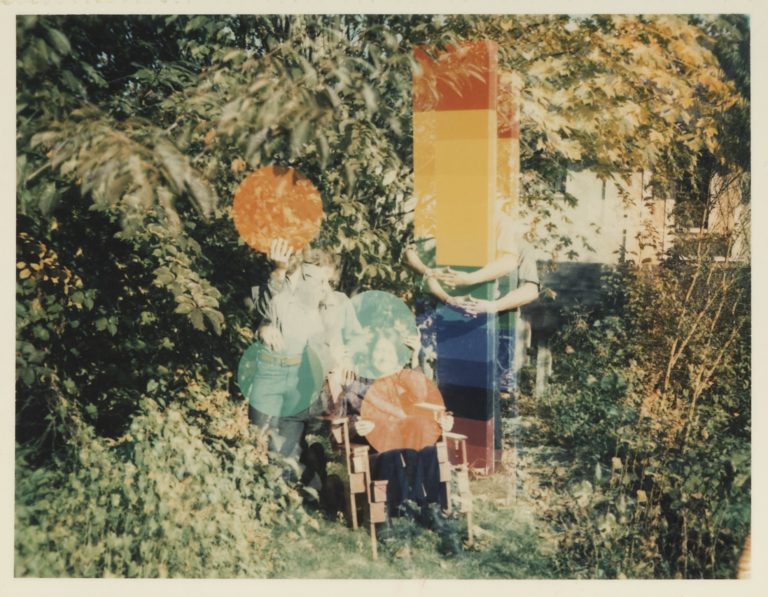
Colour research props, 1970. Photo: Michael Morris (M/T 65.14.02)

Postcard by Rain Rien (Rain Rodgers), 1973, mailed to Image Bank
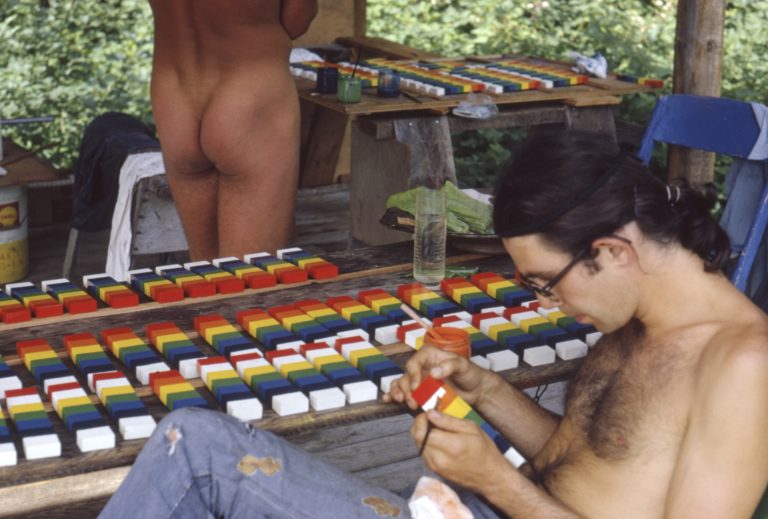
Gordon Allen painting colour bars at Babyland, 1972. Photo: Michael Morris (M/T 036.181.005)
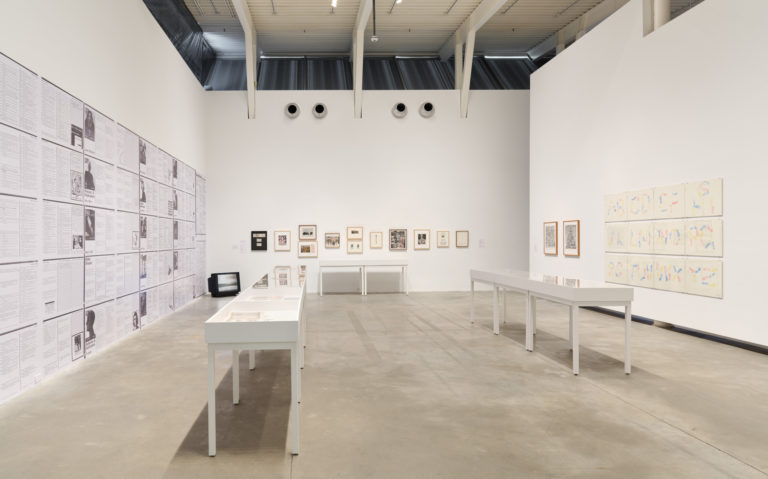
Installation view of Image Bank at the Morris and Helen Belkin Art Gallery, 2021. Photo: Rachel Topham Photography
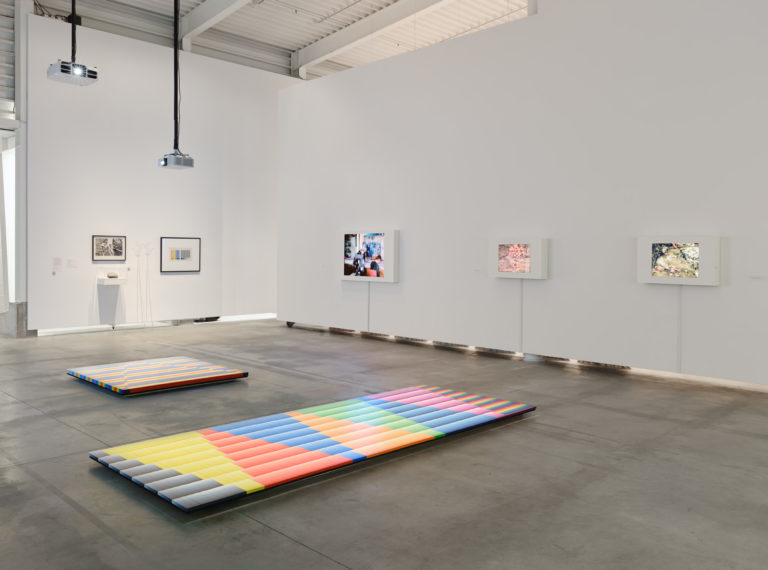
Installation view of Image Bank at the Morris and Helen Belkin Art Gallery, 2021. Photo: Rachel Topham Photography
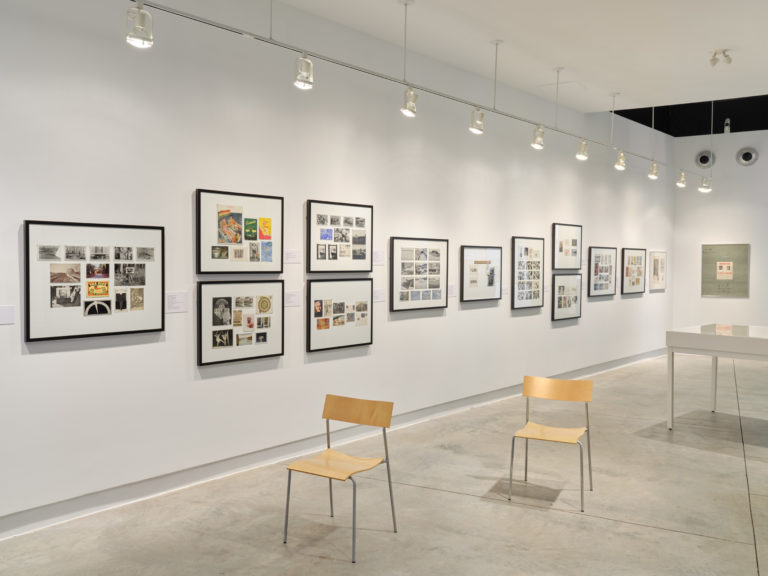
Installation view of Image Bank at the Morris and Helen Belkin Art Gallery, 2021. Photo: Rachel Topham Photography
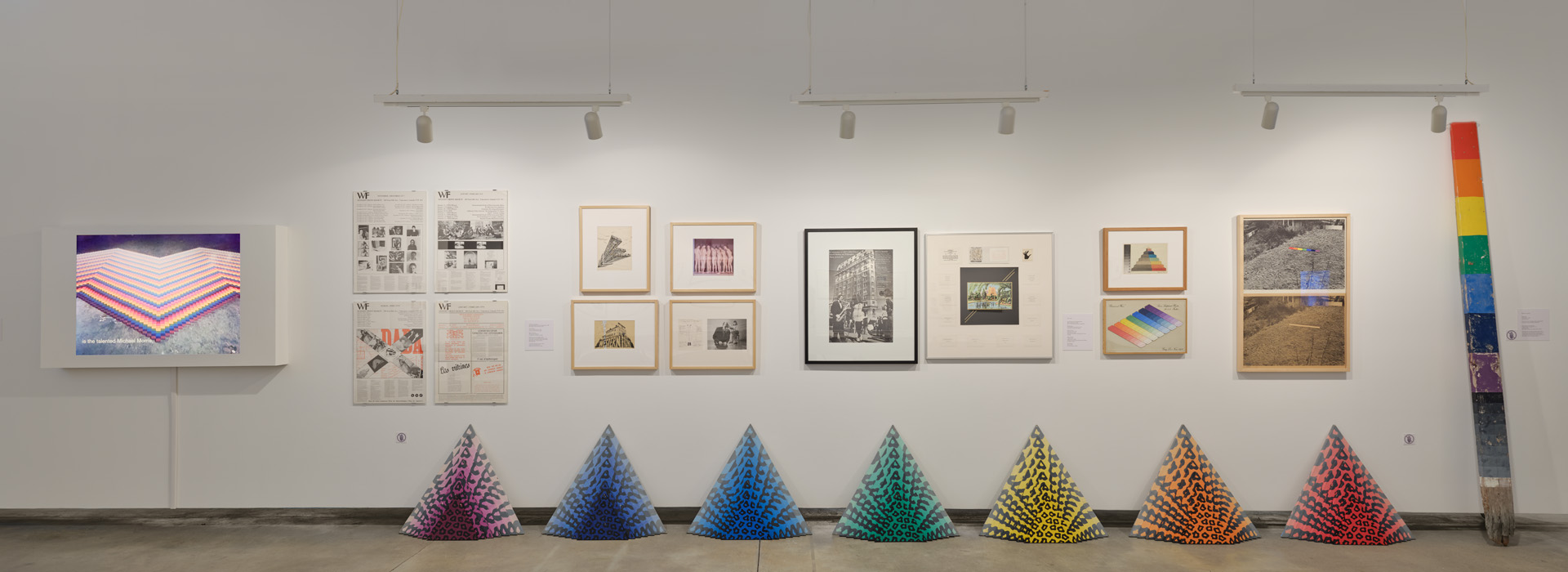
Installation view of Image Bank at the Morris and Helen Belkin Art Gallery, 2021. Photo: Rachel Topham Photography

Installation view of Image Bank at the Morris and Helen Belkin Art Gallery, 2021. Photo: Rachel Topham Photography
-
Martin Bartlett
ArtistMartin Bartlett (English, 1939-1993) was an electronic musician and composer. After immigrating to Canada in 1952, he studied English and Music at UBC under Barbra Pentland and went on to complete an MFA in composition from Mills College in California in 1968. Bartlett was interested in non-Western compositional and philosophical practices and had vital connections with the music and cultures of South Asia. He traveled extensively in Indonesia and made hours of field recordings, many of which were accompanied by vivid narrations of rituals and ceremonies he was documenting. Bartlett’s music and compositions explored a wide range of themes involving intersections between text, performance, non-musicians, hand-built electronics and live interaction with computer-controlled synthesizers, all with a persistent emphasis on live, ephemeral and collaborative situations. In 1973, Bartlett co-founded the Western Front Society with Mo van Nostrand, Kate Craig, Henry Greenhow, Glenn Lewis, Eric Metcalfe, Michael Morris and Vincent Trasov and curated the Music Program there. He was the first head of the electronic studio at the University of Victoria, where he also taught as an Associate Professor in Composition, Theory and World Music from 1975-1983. In 1982 he was made a Professor at Simon Fraser University (SFU). Bartlett later founded the Vancouver Community Gamelan in 1986. He passed away at the age of 54 in 1993 from complications arising from AIDS.
Read More
-
Taki Bluesinger
ArtistTaki Bluesinger (Takao Sekiguchi) (Japanese, Canadian, 1943-2004) was a lens-based artist. Born in Saitama, Japan in 1943, he immigrated to Vancouver, BC in 1969, after refusing an assignment from Time Magazine to go to Vietnam. Bluesinger quickly became involved in Vancouver-based artistic groups including the Intermedia Society and the New Era Social Club. Beginning in the 1970s, he participated in many collaborative photography, video and performance projects with artists Michael de Courcy, Gerry Gilbert, Glenn Lewis, Michael Morris, Vincent Trasov and Carole Itter. These projects included Image Bank (1970–1978), Background/Vancouver (1972), Video Bag (1974), The Edge of Sleep (1977), 13 Cameras (1978), The Origins of Man-Made Paradise (1978) and Teaching and Learning as Performing Arts Part II (1998). Bluesinger’s works have been exhibited nationally and internationally, and have been featured in exhibitions, including Yellow Peril: Reconsidered at Artspeak (1990), Gardens at Canadian Museum of Contemporary Photography (1998), Drawing with Light at the Canadian Museum of Contemporary Photography (2001-02) and Image Bank at the Morris and Helen Belkin Art Gallery (2021).
Read More
-
Hank Bull
ArtistHank Bull (Canadian, b. 1949) is an artist working in performance art, radio, shadow theatre, publishing and curation. Bull’s artistic practice utilizes ephemera and targets unconventional spaces and modes of improvisations. This involves his extensive work in radio and television, which he considers a medium of art.These works have included a collaboration with Patrick Ready in their production of an original radio show, The HP Dinner Show, which ran for eight years on Vancouver Co-operative Radio. Alongside his art practice, Bull is noted for his role as an arts organizer who produces networks and collaborations with artists nationally and internationally. He was an early member of the Western Front Society and a founding director of the Pacific Association of Artist-run Centres. In 1998, he co-founded Centre A, the Vancouver International Centre of Contemporary Asian Art. His work has been shown internationally, including at the Venice Biennale (1986) and Documenta (1987), and is held in the permanent collections of Musée d’art Contemporain de Montréal, the National Gallery of Canada and the Museum of Modern Art in New York. Bull was awarded an honorary Doctorate of Letters from Emily Carr University of Art + Design in 2014.
Read More
-
Kate Craig
ArtistKate (Catherine) Shand Craig (Canadian, 1947-2002) was a multimedia artist whose work spanned costume, film, performance and photography. Craig experimented with role-play and costumes in performance and video. She adopted the camera as a mediating device to challenge the conventions of realist narratives around the female body and the natural landscape. After graduating from Dalhousie University in 1964, Craig met the artist Eric Metcalfe in 1967 while attending the University of Victoria. Together, they assumed the personas of Lady Brute and Dr. Brute and became involved in mail art networks, including Image Bank, International Image Exchange Directory and the first International Satellite Exchange Directory. In 1973, Craig co-founded the Western Front Society along with Martin Bartlett, Mo van Nostrand, Henry Greenhow, Glenn Lewis, Eric Metcalfe, Michael Morris and Vincent Trasov. While serving on the board of directors at the Western Front from 1973 to 1993, Craig curated the Artist-in-Residence Video Program, which provided local and international networks for artists. Her works have been presented nationally and internationally in exhibitions and can be found in the collections of the Art Gallery of Greater Victoria, Museé d’Art Contemporain de Montréal and the National Gallery of Canada.
Read More
-
General Idea
ArtistGeneral Idea (1969-1994) was a Canadian-based art collective comprised of AA Bronson, born Michael Tims (Canadian, b. 1946), Felix Partz, born Ronald Gabe (Canadian, 1945-1994) and Jorge Zontal, born Slobodan Saia-Levy (Italian, 1944-1994). Their practice largely involved unconventional media of mail art, performance art and installation using ideas of appropriation, satire and conceptualism, often taking on political issues, most notably challenging dominant ideas of capitalist heteronormativity. Through the focus on their activities as a collective, General Idea sought to remove the individualistic notions of artist-as-genius and further queer the art space through their integration of domestic life and popular culture with artistic practice. Their work can be found in the permanent collections of the Vancouver Art Gallery, the Art Gallery of Ontario, the New York Museum of Modern Art, and the San Francisco Museum of Modern Art among others. The archive is held at the National Gallery of Canada. The collective’s activities stopped in 1994 when both Partz and Zontal passed away due to complications from AIDS.
Read More
-
Geoffrey Hendricks
ArtistGeoffrey Hendricks (American, 1931-2018) was a painter, performance and installation artist affiliated with the Fluxus movement beginning in the 1960s. Recognized for the extensive portrayals of skies throughout his work, he became known by the moniker “Cloudsmith,” given to him by Dick Higgins. Informed by his Quaker upbringing alongside an interest in Zen philosophy and thought, his work actively sought an integration between art and life, and questions of the material versus the transcendent and the spiritual versus the practical. Much of Hendricks’s practice was grounded in collaboration and queer kinship ties, and in the 1980s he became involved with Visual AIDS, an organization preserving the work and legacies of artists with HIV/AIDS. Over the course of his career, he taught at Rutgers University, the Skowhegan School of Painting and Sculpture and the Salzburg International Summer Academy of Fine Arts. Hendricks’s work has been shown internationally in numerous exhibitions and festivals. In 2003 he curated Critical Mass: Happenings, Fluxus, Performance, Intermedia and Rutgers University, 1958-1972 at the Mead Art Museum (Amherst) and the Mason Gross Art Galleries (Rutgers).
Read More
-
Ray Johnson
ArtistRay Johnson (American, 1926-1995) was an artist celebrated for his contributions to the Neo-Dada and Pop Art movements, and has been credited as a key founder of the genres of mail and correspondence art, most notably his New York Correspondence School. During his studies at Black Mountain College in North Carolina he encountered lecturers and visiting faculty including John Cage, Joseph Alpers and Robert Motherwell, who inspired his practice and interest in language and collage. In the 1950s, Johnson became known for his “moticos,” a coined term for collages that featured layered newspaper articles, photographs, fragmented lists and doodles finished with a polished surface. Alongside collage and correspondence art, Johnson’s practice included the creation of the Robin Gallery, an art space with no physical location. This immaterial gallery existed as publicity for Johnson and his network and speaks to his ubiquitous presence in the art world. Johnson’s work is collected internationally, including the collections of the Metropolitan Museum of Art (New York), the Tate Modern (London), Hammer Museum (Los Angeles) and Museum moderner Kunst Stiftung Ludwig Wien (Vienna).
Read More
-
Gary Lee-Nova
ArtistGary Lee-Nova is a Vancouver-based artist. He studied at the Vancouver School of Art (now Emily Carr University of Art + Design) (1960-61, 1962-63) and at Coventry College of Art, England (1961-62). An important figure in the West Coast scene of the 1960s and 1970s, Lee-Nova made his name as a painter working in hard-edge style. In 1970, Lee-Nova co-founded Image Bank with Michael Morris and Vincent Trasov and was an active participant in the Sound Gallery (c. 1965), Intermedia (1967-72) and the New York Corres Sponge Dance School of Vancouver under the pseudonym Artimus Rat or Art Rat. His work has been exhibited at spaces such as the Vancouver Art Gallery, Bau-Xi Gallery, University of Saskatchewan, the Western Front, the Morris and Helen Belkin Art Gallery, the National Gallery of Canada, the Paris Biennale and the Burnaby Art Gallery. His work is included in collections such as the National Gallery of Canada, Canada Council Art Bank, and Institute of Contemporary Art (London) and the Vancouver Art Gallery. Most recently, the Burnaby Art Gallery held a survey show of Lee-Nova’s work entitled Oblique Trajectories.
Read More
-
Glenn Lewis
ArtistGlenn Lewis (Canadian, b. 1935) is a contemporary conceptual artist based in Vancouver. Lewis became a central figure within Vancouver’s prolific avant-garde art scene of the late 1960s. Initially trained in ceramics, his practice expanded to include photography, sculpture, performance and video, and is often grounded in collaborative projects or approaches. Lewis’s work questions the dualities of the social and the natural, the conventional and the mythical, as well as the static and the transient, often ironically. In 1967, Lewis was prominent in Intermedia, a loose collective of artists, musicians, dancers, architects, engineers and educators who came together to explore new forms of artistic expression and equipment, influenced in part by the ideas of Marshall McLuhan, Buckminster Fuller, the back-to-the-land movement, performance and conceptual art. Lewis was first inspired to take up performance art himself after attending workshops with choreographers and dancers Deborah Hay and Steve Paxton at the Vancouver Art Gallery in 1968, and the following year participating in a performance tour with his piece Canadian Pacific and Yvonne Rainer’s Rose Fractions. Lewis received a degree from the Vancouver School of Art in 1958 (now Emily Carr University) and later a teaching degree from the University of British Columbia. He went on to study ceramics under artist and potter Bernard Leach at St. Ives in Cornwall, England from 1961 to 1963. Upon returning to Vancouver, Lewis became involved in numerous artists’ collectives and artist-run centres, including Intermedia (1967) and the New Era Social Club (1968). In 1973, he co-founded the Western Front Society with Martin Bartlett, Mo van Nostrand, Kate Craig, Henry Greenhow, Eric Metcalfe, Michael Morris and Vincent Trasov. As an educator, arts administrator and arts programmer, Lewis has curated numerous exhibitions and programs, including the Performance Art Program at the Western Front (1977-79), the Exhibition Program at the Western Front (1986-87) and the Western Front Historical Exhibition at the Künstlerhaus Stuttgart, Germany (1983). Lewis has served on numerous boards and councils, including the Vancouver Art Gallery Board of Directors and the Western Front Board of Directors. His work has been exhibited extensively across Canada and abroad.
Read More
-
Eric Metcalfe
Eric Metcalfe (Canadian, b. 1940) is a visual and performance artist known for his affiliation with the Fluxus art movement. Metcalfe’s interdisciplinary practice encompasses painting, drawing, sculpture, installation, printmaking, performance, video and film. Born in Vancouver, Metcalfe’s lifelong passions of art, jazz, drawing and printmaking began while attending St. Michael’s University School in Victoria, and he went on to pursue a BFA from the University of Victoria in 1963. Metcalfe met artist Kate Craig in 1967. Together, they assumed the personas of Dr. Brute and Lady Brute and became involved in mail art networks, including Image Bank, International Image Exchange Directory and the first International Satellite Exchange Directory. Alongside his involvement in Image Bank, Metcalfe was a co-founder of the Vancouver artist-run centre Western Front along with Martin Bartlett, Kate Craig, Henry Greenhow, Glenn Lewis, Michael Morris, Vincent Trasov and Mo Van Nostrand, where he continues to be a member. Metcalfe has received numerous awards and recognition for his work, including the Victor Martyn Lynch-Staunton Award (2000), the Audain Foundation Lifetime Achievement Award (2006), the Governor General’s Award (2008) and an Honorary Doctorate from Emily Carr University of Art + Design (2015). His work has been exhibited widely in both Canada and abroad, including at the National Gallery of Canada, the Vancouver Art Gallery, the Morris and Helen Belkin Art Gallery, the Whitney Museum of American Art and the Museum of Modern Art (New York).
Read More
-
Michael Morris
ArtistMichael Morris (1942-2022) was a painter, photographer, video and performance artist and curator. His work is often media based and collaborative, involved with developing networks and in the production and presentation of new art activity. In his roles as curator and, primarily, as an artist, Morris was a key figure of the West Coast art scene during the 1960s. Morris studied at the University of Victoria and then at the Vancouver School of Art (now Emily Carr University), followed by graduate studies at Slade School of Fine Art at the University College London, during the 1960s. There he became interested in the work of Fluxus and the European avant-garde, which had a profound influence on his work and on the Vancouver experimental art scene in general. In 1969 he founded Image Bank with Vincent Trasov, a system of postal correspondence between participating artists for the exchange of information and ideas. The intention of Image Bank was to create a collaborative, process-based project in the hopes of engendering a shared creative consciousness—in opposition to the alienation endemic to modern capitalist society—through the deconstruction and recombination of its ideological forms. Morris was acting curator of the Vancouver Art Gallery and the Centre for Communications and the Arts at Simon Fraser University and has had many guest curatorships at other institutions. In 1973, he co-founded the Western Front—one of Canada’s first artist-run centres—and served as co-director for seven years. In 1990 he and Trasov founded the Morris/Trasov Archive, housed at the Morris and Helen Belkin Art Gallery, to research contemporary art. He has established a strong international reputation and worked for many years in Berlin. Morris has participated in artist-in-residence programs both in Canada at the Banff Centre (1990) and at Open Studio (2003) and internationally at Berlin Kustlerprogramm (1981-1998). Morris has had numerous solo and collaborative exhibitions nationally and internationally, and is the recipient of numerous awards, including the 2015 Audain Prize for Lifetime Achievement in Visual Arts, the 2011 Governor General’s Award in Visual and Media Arts and an Honorary Doctorate in 2005 by Emily Carr University of Art + Design.
Read More
-
Vincent Trasov
ArtistAn important Canadian conceptual artist and a leader in the avant-garde community, Vincent Trasov (b. 1947, Edmonton, AB) is a painter, video and performance artist. His work is often media-based and collaborative in spirit, involved with developing networks. In 1969 he founded Image Bank with Michael Morris, a method for personal exchange of information amongst artists. Trasov has made videotapes since 1971. In 1973, Trasov co-founded and co-directed the Western Front Society, an artist-run centre for the production and presentation of new art activity. Trasov gained international prominence with his performance as Mr. Peanut (in a Planter’s Peanut costume), an official candidate for Mayor of Vancouver in 1974. The Mr. Peanut role was intended as, amongst other things, a commentary about the perceived merging of art and politics. In 1981, he was invited to Berlin with Michael Morris as guest of Berliner Kunstlerprogramm, DAAD. He and Morris founded the Morris/Trasov Archive in 1990, housed at the Morris and Helen Belkin Art Gallery, to research contemporary art and communication. Trasov has had numerous international exhibitions and is represented in public and private collections in both Europe and North America. He presently lives in Berlin and Vancouver.
Read More
-
May Wilson
May Wilson (American, 1905-1986) was a visual artist and a prominent figure in the 1960s and 70s feminist and correspondence art movements. Wilson used humour frequently in her art, and is well recognized for her collages and junk bricolages, in particular her Ridiculous Portrait photocollages. Wilson worked primarily as a homemaker and on rearing her two children in her early adult life, while maintaining a painting-based arts practice. It was not until she was 42, when her son Williams S. Wilson introduced her via mail to Ray Johnson, that she became involved with a group of avant-grade artists and started participating in correspondence art in earnest. At the age of 61, she decided to leave her suburban life behind and move to New York City to be a full-time artist. Some would even refer to her as the “Grandma Moses of the Underground.” Wilson’s innovative use of deconstruction, reconfiguration and adaptability of a wide range of materials offered new perspectives on abstraction. Her work has been shown widely and is included in the collections of the Whitney Museum of American Art, the Baltimore Museum of Art and the Brooklyn Museum of Art, among others. Recent exhibitions include Ridiculous Portraits at the Morristown Museum and Seductive Subversion: Women Pop Artists, 1958-1968 at the Brooklyn Museum.
Read More
Related
-
Publication
2019
Image Bank
 Image Bank explores the artistic collaboration of Michael Morris, Vincent Trasov and originally Gary Lee-Nova, including their most spectacular works – extended performances with props, such as Colour Bar Research (1970-78) and Mr. Peanut’s mayoralty campaign (1974) in which Vincent Trasov as Mr. Peanut ran for mayor of Vancouver – alongside their extensive mail-art exchanges with other networkers such as Robert Filliou, General Idea, Ant Farm and Ray Johnson’s New York Correspondence School. [more information and purchase]
Image Bank explores the artistic collaboration of Michael Morris, Vincent Trasov and originally Gary Lee-Nova, including their most spectacular works – extended performances with props, such as Colour Bar Research (1970-78) and Mr. Peanut’s mayoralty campaign (1974) in which Vincent Trasov as Mr. Peanut ran for mayor of Vancouver – alongside their extensive mail-art exchanges with other networkers such as Robert Filliou, General Idea, Ant Farm and Ray Johnson’s New York Correspondence School. [more information and purchase] -
Publication
2015
Letters: Michael Morris and Concrete Poetry
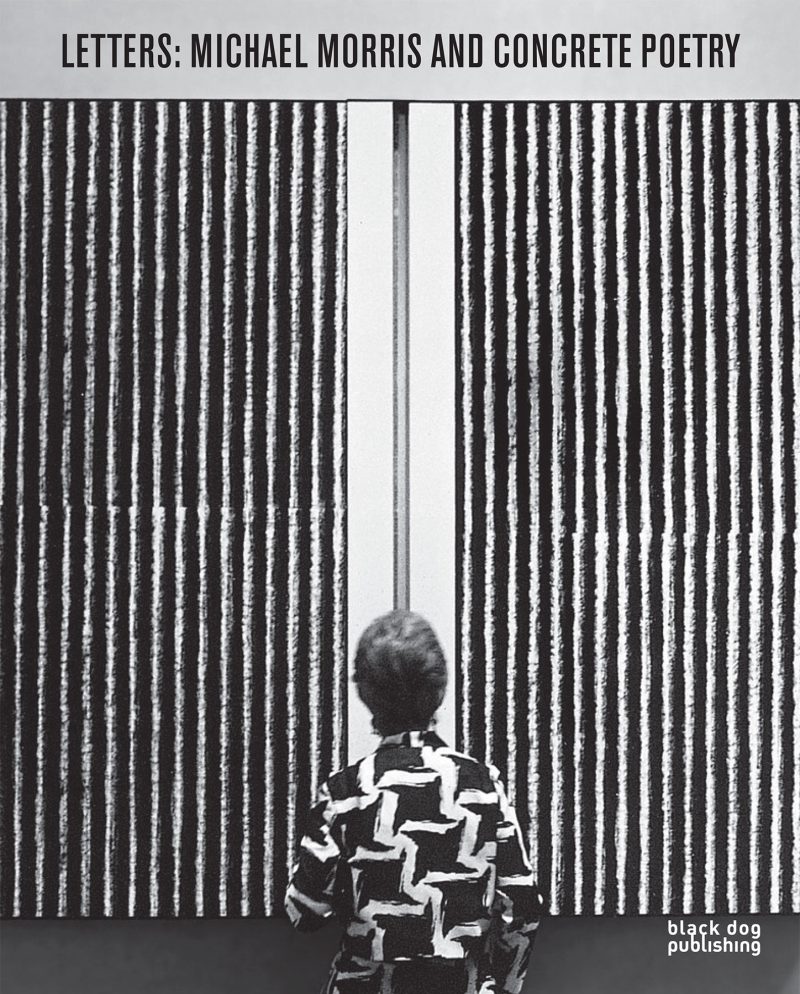 Exhibition catalogue from Letters: Michael Morris and Concrete Poetry at the Belkin (13 January-8 April 2012) with essays by Jamie Hilder, David MacWilliam, Michael Turner, Scott Watson and William Wood; edited by Scott Watson and Jana Tyner. [more information and purchase]
Exhibition catalogue from Letters: Michael Morris and Concrete Poetry at the Belkin (13 January-8 April 2012) with essays by Jamie Hilder, David MacWilliam, Michael Turner, Scott Watson and William Wood; edited by Scott Watson and Jana Tyner. [more information and purchase] -
News
17 Apr 2019
Image Bank at KW Institute, Berlin

This June 2019, a retrospective exhibition of the work of Image Bank opens at KW Institute in Berlin. Co-curated by the Belkin’s Scott Watson with Krist Gruijthuijsen and Maxine Kopsa, the exhibition pulls films, photographs, drawings, collages and other ephemera from the Gallery’s Morris/Trasov Archive to track the collaborative history of Image Bank. Founded in 1970 and lasting to 1978, Image Bank was a project initiated by Michael Morris, Vincent Trasov and Gary Lee-Nova that originated when they were all associated with the legendary Vancouver artist-run centre Intermedia. Image Bank produced a myriad of projects, including extended performances with props, such as Colour Bar Research, which involved 2,000 painted wooden bars that could be arranged into an ever-changing painting. Their most known performance is the Mr. Peanut for Mayor Campaign (1974) in which Vincent Trasov, as Mr. Peanut, ran for Mayor of Vancouver. This artistic collaboration and archive helped facilitate the exchange of ideas, images and information between artists through the use of the international postal system, thereby creating an open-ended and decentralized method of networking that presages social media.
[more] -
Exhibition
19 June 2015 – 23 August 2015
Melancholy Bay: Images of English Bay, Burrard Inlet and Howe Sound from the Collection
Melancholy Bay: Images of English Bay, Burrard Inlet and Howe Sound from the Collection began as a response to the recent oil spill in English Bay. The University of British Columbia, located on unceded Musqueam territory and only kilometres west of the ancient city of c̓əsnaʔəm, looks out over English Bay, Howe Sound and the Georgia Straight, all bodies of water renamed by George Vancouver in the 1790s. The title Melancholy Bay is a reference to Vancouver’s dispirited response to what he saw as “a sublime, though gloomy spectacle.” The settler culture that followed Vancouver to establish jurisdiction and displace the indigenous villages and place names has been consistent in admixing descriptions of majestic landscape with ideas of frontier and resource extraction. As a result we tend to naturalize the large visual imprint made by the resource extraction industries as the picturesque.
[more] -
Exhibition
25 January 2012 – 3 March 2012
Michael Morris: Palomar

Michael Morris has been a key figure of the west coast art scene since the 1960s, and his contribution to the development of Vancouver as an important city for contemporary art has been immense. Satellite Gallery presents Palomar: Michael Morris, an exhibition of work by Morris that complements his larger exhibition at the Morris & Helen Belkin Art Gallery, Letters: Michael Morris and Concrete Poetry.
[more] -
Exhibition
13 January 2012 – 8 April 2012
Letters: Michael Morris and Concrete Poetry
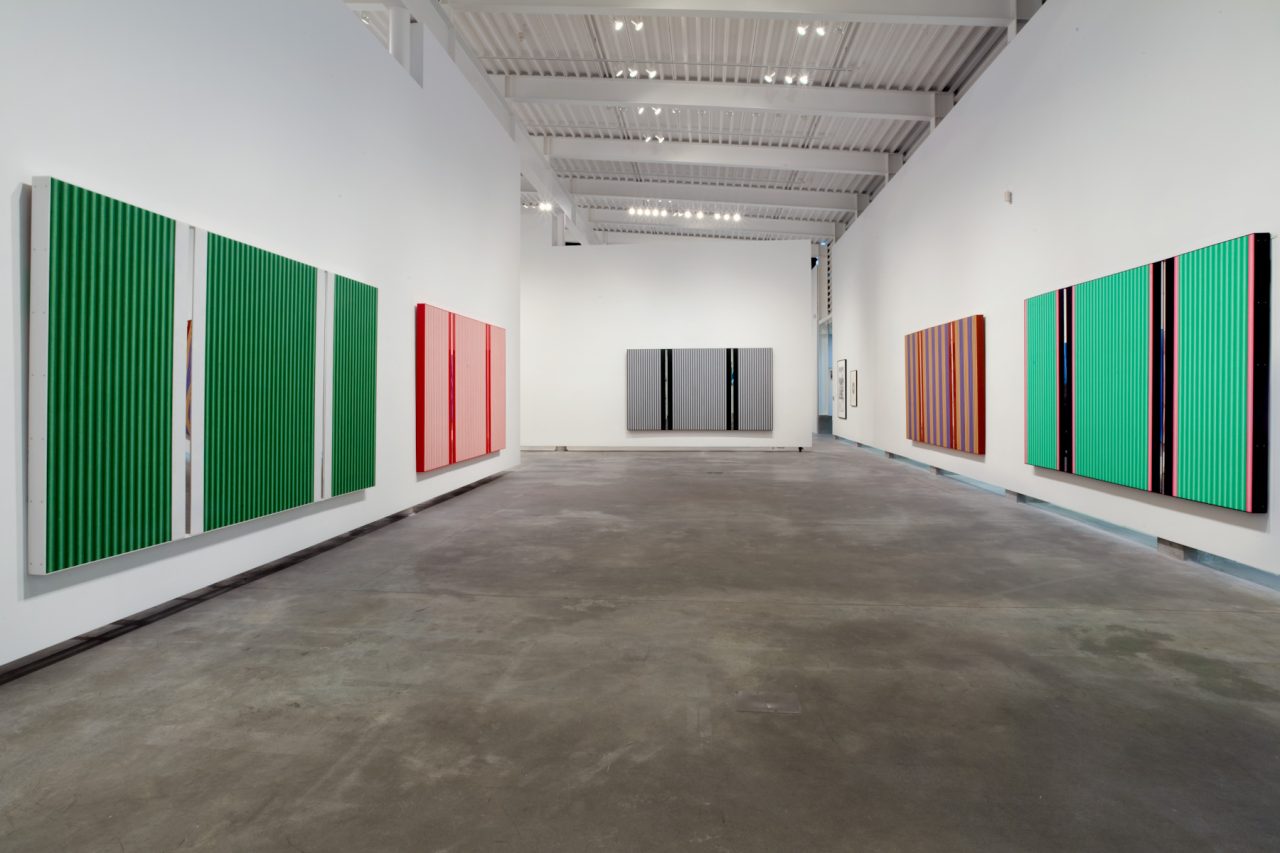
In his roles as a curator and primarily as an artist, Michael Morris has been a key figure of the west coast art scene since the 1960s and his contribution to the development of Vancouver as a contemporary art city has been immense. Morris was engaged with Concrete Poetry in the 1960s. The Concrete Poetry movement was perhaps the first global art movement, springing up in South and North America, Japan and Europe in the mid to late 1950s.
[more] -
Event
18 Jun - 22 Aug 2021
Image Bank: Image Request List 2021
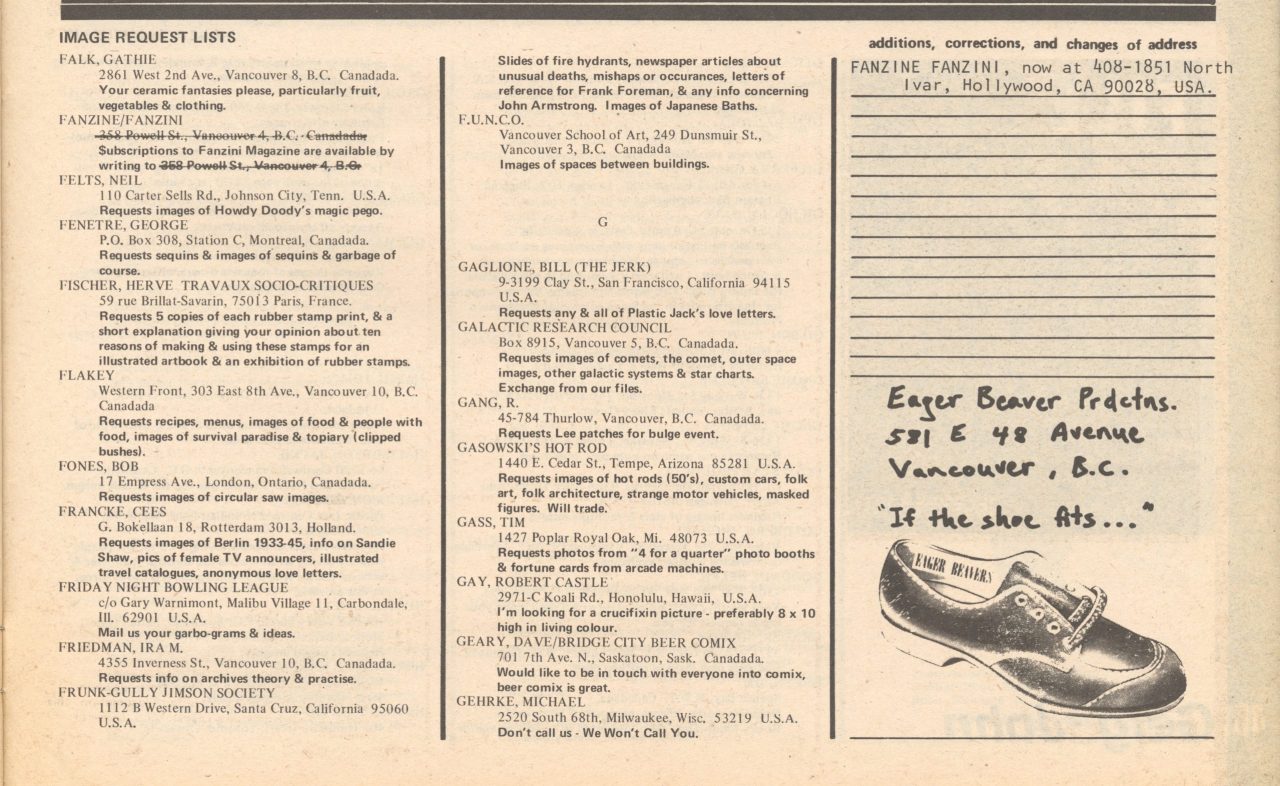
The International Image Exchange Directory (1972) and the Image Request Lists published in General Idea’s FILE Megazine (1974) are Image Bank’s most consequential works in the eyes of Michael Morris and Vincent Trasov. These directories established an international network for the exchange of mail as artworks.
[more] -
Tour
18 Jun - 22 Aug 2021
Tours: Image Bank
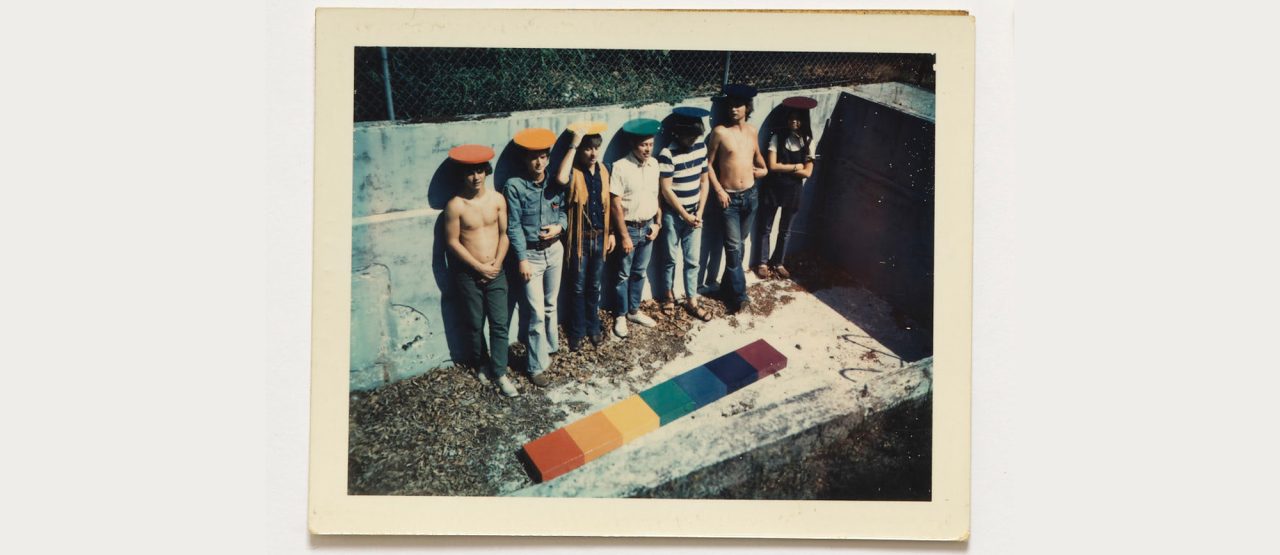
Tours and discussions of Image Bank can be arranged from Tuesday to Friday for groups and classes, lasting 50 minutes and longer. For more information or to book a tour, please contact Belkin Public Programs by email at belkin.tours@ubc.ca.
[more] -
News
17 Jun 2021
Image Bank: Reading Room

The following are resources related to the artists in Image Bank. This list is not exhaustive, but rather comprised of suggested readings compiled by researchers at the Belkin. These readings are intended to provide additional context for the exhibition and act as springboards for further research or questions stemming from the exhibition, artists and works involved. Following the introduction, resources are arranged by artist, listed alphabetically by last name. This compilation is an evolving and growing list, so check back in the future for more additions.
[more] -
Event
18 Jun 2021
Curator Tour: Image Bank with Scott Watson

Image Bank explores the artistic collaboration of Michael Morris and Vincent Trasov with others, including their most spectacular works – extended performances with props, such as Colour Bar Research (1970-78) and Mr. Peanut’s mayoralty campaign (1974) – alongside their extensive mail-art exchanges with other networkers such as Robert Filliou, Ant Farm and Ray Johnson’s New York Correspondence School. Director and co-curator Scott Watson walks through the exhibition and offers insight into some of the key works and themes, including collaborations with the artists involved in the newly founded artist-run centre, the Western Front (est. 1973) (Martin Bartlett, Hank Bull, Kate Craig, General Idea, Gary Lee-Nova, Glenn Lewis, Eric Metcalfe, John Mitchell and others).
[more] -
Event
Tue 17 Aug 2021 at 5 pm
Panel Discussion: Image Bank’s Information Systems and Economies of Desire

Please join us for a panel discussion with DJ Fraser, Felicity Tayler and Shaunna Moore, who will be exploring the limits and expanded possibilities of the archive. Thinking closely about the ethics of archival, collection and exhibition practices, the panelists will draw from the Image Bank exhibition currently at the Belkin.
[more] -
News
14 Jun 2021
Outdoor Screen: An Extension of the Gallery
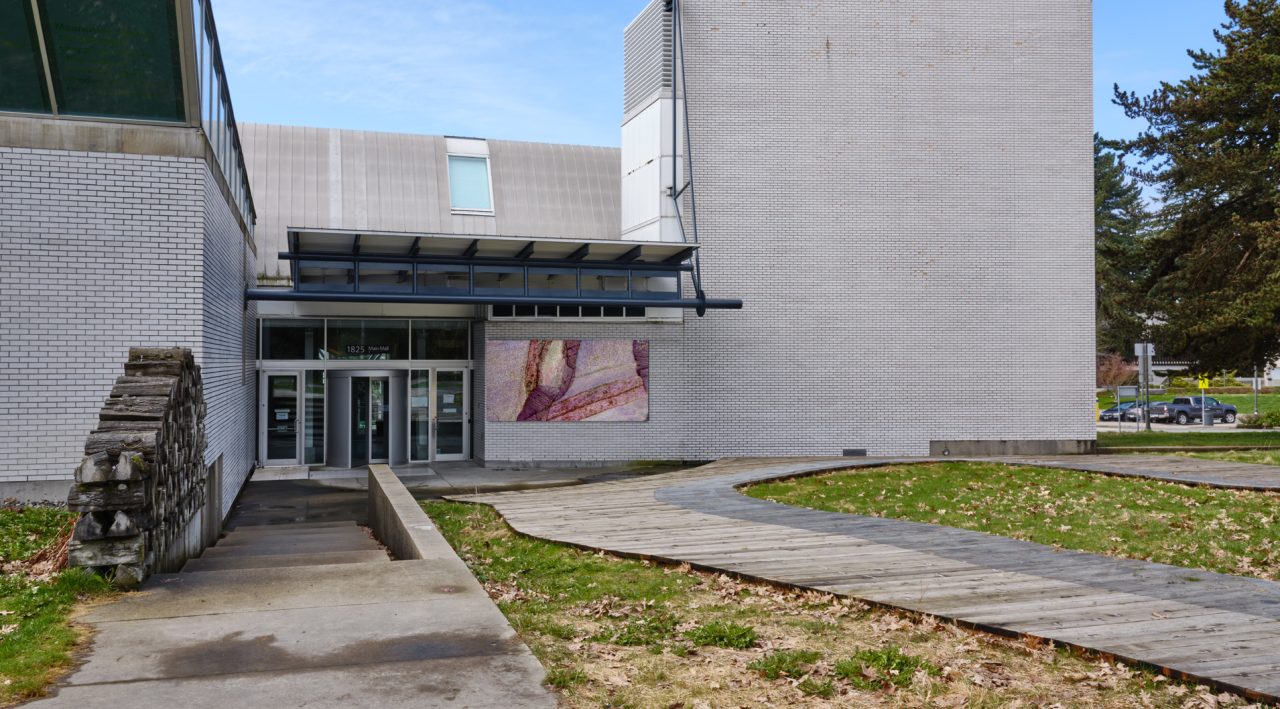
With the opening of the Image Bank exhibition on June 18, 2021, the gallery is pleased to launch the Outdoor Screen, a 4x2 metre outdoor screen curated with media works from the Belkin’s permanent collection and archive alongside work commissioned specifically for this platform.
[more] -
Exhibition
18 Jun – 22 Aug 2021
Outdoor Screen: Image Bank

This summer 2021, the Belkin's Outdoor Screen includes works related to the Image Bank exhibition in the gallery, with a special summer solstice screening of Jumana Manna's Wild Relatives (2018).
[more]